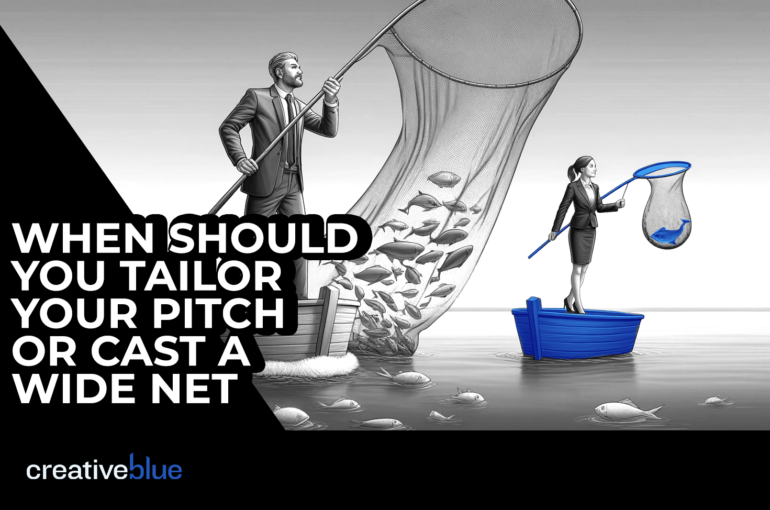When Should You Tailor Your Pitch or Cast a Wide Net?
When Should You Tailor Your Pitch or Cast a Wide Net?

When crafting a sales pitch, it’s tempting to make a generalized sales pitch that works for any given client. After all, it’s your product, right? If you get the story right on your end, it should work everywhere, right?
Recently, we had a client who had a big pitch with a Fortune 100 company at the end of the month. At first, we were trying to make a “catch all” pitch they could keep using long afterward.
But then, we realized that if they knocked this one pitch out of the park, it might open up a dozen new opportunities. And if they nailed that, future pitches would change anyway.
So, instead of making a generalized sales pitch, we made a pitch that was specifically for that meeting. Through that process, we learned a ton.
In the end, it changed the entire sales approach dramatically. Even the “generalized” sales pitch was upleveled by the exercise.
To start, we asked questions like…
Why was the meeting set up?
Who are the decision makers?
What are they looking to get out of this meeting?
We learned exactly why they landed this meeting. What the decision-makers actually liked about their product (what their hopes were), and how we could optimize the story to play up those emotions.
Since we were trying to tell a story to a specific audience, we weren’t trying to say every single thing our client could potentially achieve. They’re a neuroscience company – the potential was pretty open-ended. Instead, we focused on the much smaller features that the Fortune 100 company was actually interested in.
Yes, we still included all the future possibilities. We didn’t leave out vision. But the vision was placed strategically after we had covered the questions of the initial engagement. Since we had already built trust, they were much more likely to want to begin a long-term partnership to unlock that vision. That’s a huge win.
Their potential partner was initially interested in meeting to discuss using their technology to measure and improve training programs. The entire opening of the pitch was tailored to answer all their questions and concerns around this project. We made it our mission to prove that our client could knock that smaller project out of the park. They had all the data to back that up.
While we answered those initial questions, we also told a story. We illustrated how they got started and how the three founders’ backgrounds led them to see a unique opportunity. We painted a picture, but we mostly stayed focused on what the meeting was set up for.
The pitch went really well.
The people that set the meeting felt heard. We showed that we understood what they actually wanted. Then they were much more open to hearing about the future potential and what additional opportunities could be explored. Imagine if I could scan your brain while you looked at a box of Lucky Charms to see if you really liked it. That’s the kind of thing they will be able to do.
“The potential applications here are, dare I say, magically delicious?” – Ashley Johnston, Head of Operations
Our client set themselves up as a key player in not only the immediate business objective, but a future of additional engagements. They did that by not trying to boil the ocean with their initial pitch. Instead, figuring out exactly why they were asked to have that meeting and spending the time to address that specifically.
And then that opened the door for a longer term partnership.
And that is the goal of any presentation.
And so, if you know who you’re presenting to, if you have any information on that, it’s always worthwhile to tailor a presentation specifically to the audience that you’re speaking to. In the end, we are not making a pitch for everyone.
One deal could change your business forever, like it did for our client.
If you have a big sales pitch coming up, reach out to us and see if we can help you knock it out of the park.
